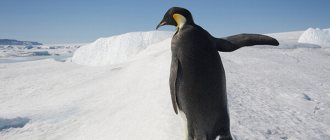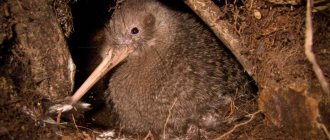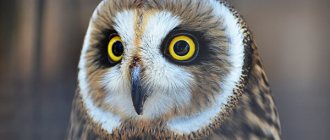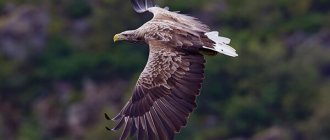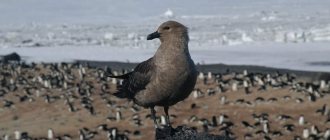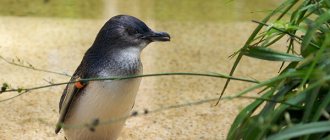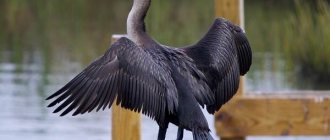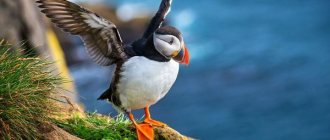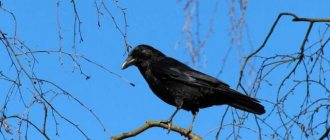Description and features
The king penguin reaches a height of 1 m. Its beak is thinner and more graceful than that of the emperor. The beak color is pinkish-yellow. The weight of the king penguin ranges from 9 to 17 kg. The female is slightly smaller, the male is larger. The bird's head is painted black. On the sides, closer to the back of the head, there are bright orange spots with a yellow tint.
The throat is painted in the same color, in the form of a frill, brighter at the top, paler below, gradually lighter to white. The bird's belly is all white. The back and fins are black with a silver tint, the upper and lower parts of the body are separated by a black stripe.
The body is dense, thickened in the middle, becoming sharper at the top. The head is small, the beak is also small, straight, strong, with sharp edges. The wings are more like fins, even the feathers on them look like scales. The feet are dark blue and webbed for swimming.
The pupil of the eyes can contract and enlarge very quickly, so the bird sees perfectly in water, even at a depth of 100 m. The cornea of the eye is flat, which makes them slightly myopic on land. The ears, like those of all birds, are barely visible.
When diving, they are covered with long feathers to keep water out. They communicate on land using sounds reminiscent of a rattle or trumpet whistle. Underwater communication is silent.
The king penguin in the photo is truly an august person. Its plumage is similar to a mantle. Royalty is added by the high-headed posture and impressive body shape. Being in polar cold conditions, this inhabitant of the southern latitudes survives due to the multi-layered nature of its plumage.
There can be up to four of these layers, they are quite dense, and the uppermost one is saturated with fat, therefore impenetrable to ice water. The three bottom ones serve for thermal insulation. Amazing wetsuit.
The chick does not have a top layer of feathers, and the other three are more like warm brown fluff. It warms the baby, but does not save him in the water. Therefore, they do not enter the icy waters of Antarctica until they are two years old.
This creature can even drink salt water. The melting snow is not enough to quench the thirst of hundreds of thousands of colony inhabitants. The ice is too hard and difficult to break with its beak. Therefore, nature took care of amazing creatures.
She equipped them with special glands located at eye level that filter salt from the blood. They expel salt through their nostrils in the form of a highly concentrated solution that drips from the penguin's beak.
Physiology also allows him not to sweat or excrete urine. They replace it with uric acid in the form of a cloudy white liquid. These birds have a very careful and economical attitude towards liquid.
Egg laying and brood reduction
Not all penguin eggs hatch successfully: especially in young couples, the chicks often do not even hatch; It was found that less than 33% of chicks hatched in two-year-old parents. The success of hatching, however, increases sharply with age and reaches more than 90%; Only in very old penguins does this figure drop again to 75% due to decreased fertility. After copulation, in which the male is forced to balance on the partner’s back, eggs are laid. While emperor and king penguins incubate their single egg on their feet, the females of all other penguin species lay two eggs within three to five days in a regular nest, which they build from materials widely found in nature - grass or fine grass. pebbles. The eggs are white or greenish in color.
In most cases, the first egg is slightly larger than the second, so the first chick hatches earlier.
While in most species brood reduction occurs only when food supplies are limited, the crested thick-billed penguin ( E. pachyrhynchus
) even almost always raise both chicks, for crested penguins, brood reduction is the norm.
It is noteworthy that the second egg of these penguins is larger than the first (the percentage ratio is 20 to 70), and it is from the second egg that the first chick hatches. The incubation period for different species ranges from one to two months. As a consequence, parents give preference to the older and larger chick, for example, it regularly receives more food than the one that hatched later, as a result of which the second chick in most cases soon dies. This so-called brood reduction is an evolutionary adaptation to limited food supplies: the early death of the second chick increases the chances of survival of the first, since there is no need to divide limited resources between two chicks. At the same time, the second egg is a kind of “insurance” for the parents in case of the early death of the first chick. Raising chicks Raising chicks is divided into two phases: In the first two to three weeks (even six for emperor penguins), the chicks are under the constant supervision of one of the parents, while the other goes in search of food.
When the chicks grow up, they are sent to a “kindergarten” - a group of young animals, and then both parents get food at the same time. Depending on the species, such groups, also called nurseries, can consist of a few animals from neighboring nests, as in chinstrap or jackass penguins, or several thousand individuals, as in Adélie, subantarctic, or emperor penguins. Feeding times vary among species: subantarctic penguins feed their offspring daily, Adelie or chinstrap penguins every two days, emperor penguins often only once every four days or even less often. However, the chicks of the latter receive more food at a time.
Penguin parents of species that do not reside permanently in colonies leave the colony soon after molting (crested penguins, for example, within a week). In most cases, parental care ends here - cases of feeding chicks at sea are unknown, and besides, it is hardly feasible. Subantarctic penguin chicks, which live near the colony all year round, return to their parents for another two or three weeks and receive additional food; but after that they too are left to their own devices. The amount of food in most cases corresponds to the stage of development of the chicks, but in relation to body weight it is always plentiful: Even the chicks of small penguin species receive 500 g of food at one time; Emperor penguins give their offspring up to one kilogram of fish at a time. King penguin chicks may be even heavier than their parents after 12 months.
However, these amazing birds are not only the indigenous inhabitants of Antarctica, since penguins also live, for example, in... Africa (yes, such a paradox), but only in its southernmost part, on the territory of South Africa (South African Republic). These flightless birds with interesting habits and unusual appearance have long been the object of study by many zoologists, the heroes of children's cartoons (such as Madagascar). The word “penguin” itself, according to one version, is of Welsh origin and comes from the words “pen” - head and “gwyn” - white, which was the original name for the now extinct great auk, which was very similar to penguins, and this name later passed on to them. According to another version, the name “penguin” comes from the English “pinwing”, which means wingspin. And finally, according to the third version, the name of penguins is of Latin origin, since in Latin the word “pinguis” means “fat”.
Types of penguins
The penguin family includes 18 species. Their common quality is the inability to fly. Clumsy on land, they are very good swimmers. The forelimbs of all are more like flippers. Let's look at the most famous types:
1. The largest is the emperor penguin. Its height reaches 1.2-1.4 m, weight about 23 kg. The plumage color is black and white with bright purple accents on the cheeks and neck. It dives very deep, up to 500 m. They usually hunt in groups.
2. Adelie Penguin. This is an average-sized representative, about 70 cm, weight up to 7 kg. There is a border of white feathers around the eyes.
3. The crested penguin is not a very large species of penguin. It is up to 60 cm tall and weighs up to 3 kg. There is an ocher stripe above the eyes and protruding black feathers on the head in the form of a crest. The eyes are red. There are northern and southern representatives.
4. The golden-haired penguin is quite beautiful. Not very tall, under 80 cm, with gold-colored feathers around the eyes and on the head.
5. The little penguin is the smallest of all. His height is only 40 cm and his weight is about 1.5 kg. The feathers on the back, wings and head are not black, but dark blue. He is a remarkably loyal family man among the penguins. Creates one pair for life. They live mainly in southern Australia. They dig holes on the shore. They dive shallowly, up to 50 m. The eggs hatch for 30-40 days.
6. The yellow-eyed penguin is of medium height, about 80 cm, weight up to 7 kg. The eyes are surrounded by a yellow border. The legs and beak are reddish. They do not live in groups. They are very rare, with barely 4,000 adult pairs remaining.
7. Chinstrap penguin height up to 70 cm, weight up to 5 kg. On the top of the head there is a white stripe of feathers from ear to ear. Swims over very long distances, capable of moving up to 1000 km from land. Dives to depths of up to 250 m.
8. The subantarctic or gentoo penguin is a rather large bird. Height up to 90 cm, weight up to 9 kg. Notable for the white edging around the eyes. Moves rapidly underwater, reaching speeds of up to 36 km/h.
9. The Galapagos penguin is unique in its habitat. He is the only one who lives near the equator, swimming in warm water under the hot sun. The individual is small, up to 50 cm, weight up to 2.5 kg. Unfortunately, the species is considered endangered. There are now about 2,000 adult couples left.
10. Spectacled penguin, also donkey, blackfoot or African. It makes sounds similar to the cry of a donkey. Lives in southern Africa. Average height, up to 70 cm, weight up to 5 kg. There is a black horseshoe-shaped stripe on the stomach. There is a pattern around the eyes that looks like glasses.
Lifestyle and habitat
The king penguin lives in the northern part of Antarctica. Its homeland is small islands with a temperate climate near Antarctica and islands near Tierra del Fuego. There they gather in colonies, live, and reproduce. They can sometimes be found in southern Chile and Argentina.
On land they move awkwardly on two legs, helping themselves with small wings, like hands. But in the sea they are surprisingly mobile. Their streamlined body helps them swim quickly through rough seas. They dive and swim to the surface even in the most severe storms. The purpose of their swims is hunting.
They catch prey in the water - various fish, crustaceans and soft-bodied animals. They usually hunt alone, but prefer to live in groups. Discipline and hierarchy are observed in the colony. The best place is in the center, it is very warm and safe.
It is important for these birds to live on land, but have open access to the sea. The most dangerous enemies in nature for them are leopard seals, seals and killer whales. The cubs may be attacked by brown skuas or petrels. But even more terrible and dangerous for them was the man who hunted them for their blubber and meat, and partly for their skin.
Once a year they molt. New feathers seem to push the old ones out of his “fur coat”. Then the birds do not swim and wait out the molt in a secluded place. At this point they are forced to starve.
Penguins are not what they seem
We begin the story with penguins, whom evolution has punished on all fronts: they cannot fly, are forced to live in the snow in the Antarctic region and fight aggressive predators that hunt them in cold waters.
In addition, they are forced to endure violence from the Navy SEALs. Researchers have repeatedly observed very strange scenes: male fur seals attacked penguins not for hunting (which also happens), but in order to satisfy their sexual needs. It is difficult to say what causes such interest in another species, but scientists suggest that this is done by young sexually excited males who are not yet ready to mate with females. Watching their relatives having sex, they experience tension - and get rid of it by using birds as sex toys. Biologists have not yet found a more logical explanation. But not all penguins are helpless victims of abusive cats. These birds themselves know a lot about sexual deviations. They steal children, engage in prostitution and necrophilia. Adelie penguins are especially successful in this. It is customary for this species to make its nests from cobblestones, but finding them in icy wastelands is quite problematic. Therefore, some “married” females, not wanting to engage in tedious stalking, find lonely males remaining to guard the nest and offer them sex, adopting a mating position. The male, bored with housework, accepts this offer, and after the end of sexual intercourse, the female takes a “payment” for her services in the form of several stones and drags them to her nest.
It is unknown whether partners of walking females experience jealousy. But at least sex brings them pleasure and not pain. In some species, mating is a truly creepy process worthy of a horror plot.
Nutrition
The royal's menu consists of fish and seafood. Their main source of food is the sea. They catch anchovies, Antarctic silverfish, herring, sardines, krill, shrimp, squid and various shellfish.
To survive in the cold, they need to eat well. Living in different conditions, they adapt to the local diet. For example, some catch more crustaceans, although they have to dive more often to get enough.
They make from 190 to 800-900 dives. This depends on climate conditions, food requirements and the type of penguin. Birds that eat fish spend less energy hunting. They suck small prey into their mouths like a pump, along with water. During molting or hatching chicks, they are forced to starve. Then up to half of the body weight is lost.
What does a penguin feel like?
It feels roughly like a smooth-haired cat, albeit wet.
Interesting materials:
What is the difference between cowardice and fear? What is the difference between centrifugal and centripetal forces? What is the difference between digital x-ray and CT? What is the difference between a basement and a basement? What is the difference between metallic color and pearl color? How does an eau de toilette tester differ from the original? What is the difference between a military training center and a military department? What is the difference between udon and ramen? What is the difference between an instruction and an order? How is the mind different from consciousness?
Reproduction and lifespan
These birds seriously devote a significant part of their lives to reproduction. In spring or early summer they return to their old nesting sites, and from this moment vigorous mating activity develops. King penguins live in large groups during the breeding season.
They are all crowded together on one piece of land, and those that do not fit go into the water. The birds on the ground line up like a regiment of soldiers, not only in rows, but also in height. Young individuals are in one place, molting ones are in another, brooding females are in a third, and males are in a fourth.
They have the longest breeding season of any bird. From marriage and egg laying to the appearance of offspring, 14-16 months pass. A pair of penguins would happily breed every year, they do everything possible to do this, but it usually happens once every 2 years. Sometimes males cannot divide the female.
Then you can watch the fight between the contenders. But the choice remains with the female. Having decided on a couple, they perform a beautiful mating dance. They do not make nests, but choose areas of land that have thawed from the ice for laying. There they dig deep holes in the frozen ground.
The nest consists of a hole and is very deep. Sometimes such burrows communicate with each other through underground passages. Smooth paths, like sidewalks, lead to the nesting site. The female lays one egg on her paws, hiding it under the folds of her abdomen.
And for 55 days he and his father alternately kept him in this position. Moreover, these birds can steal each other’s eggs if their own cub dies. Their parental instinct is very great. Therefore, the couple vigilantly monitors their egg both day and night.
When a king penguin chick is born, one of the parents goes to sea to look for food. The second one stays and warms him with its warmth. And this lasts until the baby learns to warm himself by regulating his body temperature. The baby grows up under the caring care of his mother. The lifespan of birds in the wild is approximately 20-25 years. With good care, the zoo had long-livers up to 35 years old.
Golden shower and sex for all occasions
The most loving creatures on earth are definitely bonobo monkeys. After all, even people have not come to such a cult of sex as these guys. It happens to them always and in any situation: for acquaintance, conflict resolution, greeting and reconciliation. Make love, not war. In addition, they have access to various manifestations of it, including face-to-face sex, rare in the animal world, oral sex, kissing, homosexual relations, polygamy and even masturbation.
And a little about giraffes and their tastes. When looking for a partner, they don’t care about her eye color or how many partners she’s had before. All they need to do is taste her urine. This is how a male looks for a female ready to mate: he buries himself in her rump, receives samples and “calculates” whether there are enough of the necessary chemical compounds there, using his animal instinct, of course. It’s scary to imagine what some loser giraffe has to go through until he finds the one. So if you're having trouble in relationships, think about giraffes. If you don't get along, it's not the worst thing that could happen to you.
Interesting Facts
Penguins dive deeply because they can see easily in poorly lit water. Their pupil has the unique ability to quickly contract and enlarge. Perhaps they even see ultraviolet rays. Analysis of the pigment spectrum of the pupil shows that the bird sees better in the blue part of the spectrum than in the red. This ability probably arose as a result of evolutionary adaptation.
Many have heard Mikhail Zadornov’s satirical story about the “penguin flipper.” There is a special serviceman in the ranks of the United States who saves overturned birds from extinction. And they fall on their backs, raising their heads high and looking at the low-flying planes and helicopters. Then they are unable to get up on their own. This takes place in the Falkland Islands.
Penguins are the real thieves. They steal not only eggs from unwary parents, but also pebbles for laying eggs. Female penguins choose the thicker one from two males. It more reliably protects the egg in its folds of the abdomen during alternate incubation.
Linux Torvalds chose a penguin as the logo for his operating system because once at the zoo he was bitten on the finger by this feathered one. The penguin's ancestors saw dinosaurs, as evidenced by the fossilized remains of ancient relatives of the bird found by scientists. Their age is about 60 million years.
The temperature inside the colony huddled in a dense group reaches 35°C, while outside it is much lower, minus 20°C. Sometimes they switch places to keep others warm, showing rare decency and mercy.
